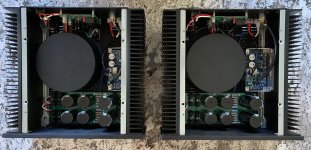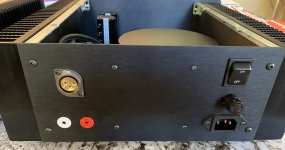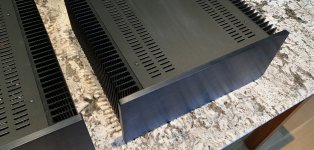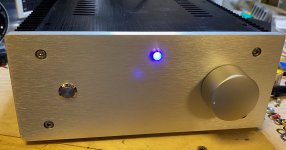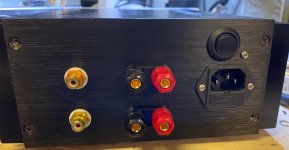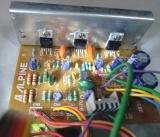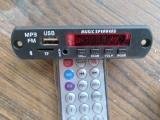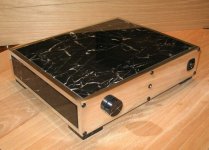The DAC has a (digital) volume control. I'm currently using an Asus Xonar U7, but I've started work on designing a replacement with balanced outputs.
The DAC has a (digital) volume control. I'm currently using an Asus Xonar U7, but I've started work on designing a replacement with balanced outputs.
thanks a lot !
 🙂
🙂Superbly done, I really like the way you've done the layout. I wish we could get plywood like that in the UK.
Cheers
Thanks! It's just some unusually cheap 12mm baltic birch I found at a home improvement store... I'm sure it's possible to get equivalent ply in the UK. The piece I used for the front panel has a bit more characterful grain than typical.
Modulus-286 Monoblocks
I'm a big fan of monoblocks because I can put the amps right next to the speakers with very short speaker cables, there is reduced risk of ground loops, and I've generally found the imaging is a bit better from improved channel separation.
I built this pair using Neurochrome's Modulus-286 (LM3886 based) amp modules. I also like over-spec'ed power supplies because I've found with other amps I've experimented with that the sound is a bit fuller and richer. I don't know if that's the case with the Mod-286, but I don't think it can hurt.
I'm using an XRKAudio soft start board feeding an Antek 25v 400VA transformer. The PS board is a cheap board I bought on ebay. It didn't have a snubber circuit, so this is added on the back side. This is a CRC design with 2x15,000 uF on each rail in the first bank, and 22,000uF in the second.
The speaker connections are GR-Research tube connectors which minimize the amount of material between the speaker cables and the connection wires inside the amp.
I only have a small number of hours on the amps at this point, but they are sounding very nice - better than the FirstWatt F5 Turbo monoblocks I built - driving my GR-Research NX-Otica open baffle speakers (93db/w).
I'm a big fan of monoblocks because I can put the amps right next to the speakers with very short speaker cables, there is reduced risk of ground loops, and I've generally found the imaging is a bit better from improved channel separation.
I built this pair using Neurochrome's Modulus-286 (LM3886 based) amp modules. I also like over-spec'ed power supplies because I've found with other amps I've experimented with that the sound is a bit fuller and richer. I don't know if that's the case with the Mod-286, but I don't think it can hurt.
I'm using an XRKAudio soft start board feeding an Antek 25v 400VA transformer. The PS board is a cheap board I bought on ebay. It didn't have a snubber circuit, so this is added on the back side. This is a CRC design with 2x15,000 uF on each rail in the first bank, and 22,000uF in the second.
The speaker connections are GR-Research tube connectors which minimize the amount of material between the speaker cables and the connection wires inside the amp.
I only have a small number of hours on the amps at this point, but they are sounding very nice - better than the FirstWatt F5 Turbo monoblocks I built - driving my GR-Research NX-Otica open baffle speakers (93db/w).
Attachments
Hello LE,
Lovely ply you used there very well done indeed. May I ask where you obtained the wood I had no idea such stuff was still available.
Cheers - J
It's just fairly cheap/low quality 18mm ply from B&Q (a big UK DIY chain store). I hadn't seen ply with this sort of top/bottom veneer before, but I imagine it's actually just there to disguise the poor quality of the interior plys. I spent 15-20 minutes in the store trying to find two sheets which were both relatively flat & didn't have too many voids in the ends & was only partially successful! It has a dozen coats of satin varnish on it, which certainly helped the aesthetics.
G'day Folks,
My I present my latest work.
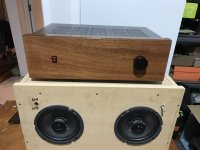
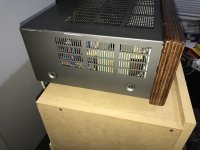
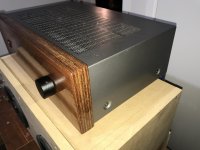
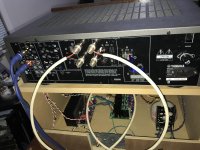

The idea here was an exercise in salvage and cost minimisation.
The chassis and heatsink are from a Yamaha HTR-5630 RDS AV reciever.
The power transformer is from an Onkyo TX-SR606, 550w nominal with 21-0-21 taps perfect for some LM3886 chips driving 4ohms.
Total cost for heatsink, chassis and power TX was about $70nz or something like USD35.
I boxed in the front of the chassis with some mild steel sheet to maximise the shielding of the chassis. (Bloody cheapo OEM manufacturers and their half cages). A chunk of 28mm brown wood ply was chiseled out in the back to slide of the boxed in steel front and work around the Yamaha design. Many coats of Danish oil and a gloss clear coat were used for finishing.
The amp boards are 00940's open source LM3886 boards.
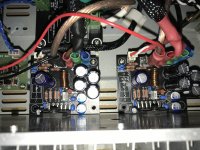
Preamp boards are a home brew creation using both sides of a LME49720 per channel, gain is 1.66x per stage with the volume control nested in between the 2 stages.
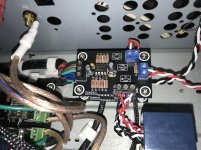
The main power supply is a home brew creation designed to use a bunch of Panasonic AMX series 3300uF 50V I got on clearance from Farnell.
The Preamp power supply uses my implementation of Elvee's Denoiser.

The speaker protection uses Rod Elliots P33.

For the sake of aesthetics, I drilled a hole in the heatsink to run a shaft extension on the volume control. This allowed me to place the knob more towards the centre which with early mock ups looked much nicer.
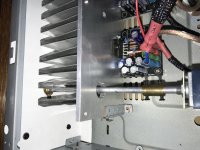
My I present my latest work.





The idea here was an exercise in salvage and cost minimisation.
The chassis and heatsink are from a Yamaha HTR-5630 RDS AV reciever.
The power transformer is from an Onkyo TX-SR606, 550w nominal with 21-0-21 taps perfect for some LM3886 chips driving 4ohms.
Total cost for heatsink, chassis and power TX was about $70nz or something like USD35.
I boxed in the front of the chassis with some mild steel sheet to maximise the shielding of the chassis. (Bloody cheapo OEM manufacturers and their half cages). A chunk of 28mm brown wood ply was chiseled out in the back to slide of the boxed in steel front and work around the Yamaha design. Many coats of Danish oil and a gloss clear coat were used for finishing.
The amp boards are 00940's open source LM3886 boards.

Preamp boards are a home brew creation using both sides of a LME49720 per channel, gain is 1.66x per stage with the volume control nested in between the 2 stages.

The main power supply is a home brew creation designed to use a bunch of Panasonic AMX series 3300uF 50V I got on clearance from Farnell.
The Preamp power supply uses my implementation of Elvee's Denoiser.

The speaker protection uses Rod Elliots P33.

For the sake of aesthetics, I drilled a hole in the heatsink to run a shaft extension on the volume control. This allowed me to place the knob more towards the centre which with early mock ups looked much nicer.

Last edited:
Good on ya! I love the cost minimization approach. I did something very similar to my LM3886, which I just set up again in my electronics shop today. Same weird chassis that i cobbed together, like yours, with a wooden front. It's posted here somewhere...
Hum free XY pcb for LM 3886
How did you manage to get the XY LM 3886 Hummmmmm-free?
View attachment 868004
This is my newly rebuilt dual mono XY lm3886 amp
I've used mur860 for rectification and Carl filipe snubberized psu
How did you manage to get the XY LM 3886 Hummmmmm-free?
This is a 2.1 amp, 3 x 2030A, and a FM/USB/SD Card module, together they cost about $ 3.50 onward here, transformer, pots etc. are extra.
A 4558 is used to filter frequencies and drive the third chip for the woofer.
2.1 means stereo and woofer.
4.1, meaning 4 channels, and woofer, starts about 5 dollars for populated PCB, and the chips may be 2030A or 1875, depending on the different kit makers.
Slightly more expensive ones are available with Keltron (Indian licensee of Sprague) capacitors.
For about $3.50, a populated PCB with stereo output, 4440 IC, 12 volt supply is also available.
All chips are Chinese.
Not super quality, but clean and okay for a small room.
A 4558 is used to filter frequencies and drive the third chip for the woofer.
2.1 means stereo and woofer.
4.1, meaning 4 channels, and woofer, starts about 5 dollars for populated PCB, and the chips may be 2030A or 1875, depending on the different kit makers.
Slightly more expensive ones are available with Keltron (Indian licensee of Sprague) capacitors.
For about $3.50, a populated PCB with stereo output, 4440 IC, 12 volt supply is also available.
All chips are Chinese.
Not super quality, but clean and okay for a small room.
Attachments
Last edited:
 Please resize your photos before posting them. 1800 pixels wide is the maximum ever needed, 1300 is more practicle.
Please resize your photos before posting them. 1800 pixels wide is the maximum ever needed, 1300 is more practicle.Looks good.Thought I'd throw an oldie into the thread... My first amp build about 15 years ago. Simple internally, a gain clone chip amp kit.
- Home
- Amplifiers
- Chip Amps
- Chip Amp Photo Gallery
